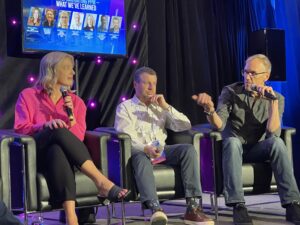Has PPM made radio worse? That question, posed by Edison Research President Larry Rosin, was followed by a long pause at Radiodays North America as a panel of programmers tackled the efficacy of the measurement system as it marks its 10th anniversary.
One point the panel agreed upon was that programmers have gotten better at responding to the limitations of PPM, which initially saw stations overwhelmingly move to shorter talk breaks in response to the finding that when the music stopped, metrics would go down.
“I think it’s hurt us because we haven’t developed talent in the way we should have because we told everyone to stop talking and keep breaks too tight, and that diminished personality,” said Sarah Cummings, Director of Radio Content, iHeartRadio and Orbyt Media. “And I think what we know for sure is that personality is the most important piece.”

Rosin agreed, saying the methodology had led to the minimization of the one thing that differentiates radio from an app-based environment.
Chris Ebbott, VP of Programming at Audacy, said another by-product of PPM that he doesn’t think U.S. stations can recover from is the loss of marketing budgets.
“We marketed because we had to try to get people to remember that they listened to us to write it down in the diary, and [as PPM rolled out] the thinking was ‘we don’t have to market anymore.’ In the states, the amount of marketing support radio stations get is minuscule compared to what it was,” Ebbott told the session.
“I’d say ratings get in the way,” asserted Christian Hall, National Programmer – Adult Hits for Rogers Sports & Media and the Content Director for JACK 96.9 and SONiC Radio in Vancouver. “I think it’s homogenized the product a bit too much and we tend to play it safe because the metrics tell us it’s an ankle-deep pond that we can walk into and we’re staying away from the deep end.”
“I think that’s boring and I think the stations that are all successful across the country have one thing in common – they built their brand over time through great programming loyalty or they’ve taken chances that allow them to step out into the light that made them a little bit more unique than the other offerings out there and if that gets washed away under this safety of what the metrics tell me what to do, we’re just going to keep watering down the product to the point where we all just sound the same,” Hall continued.
Product hasn’t evolved
Cummings also pointed to being in a position where you have number one ratings and don’t have a number one sounding radio station, and vice versa.
Illustrating that point, Ross Winters, Director of Programming, for Pattison Media, raised sample concerns around the latest PPM book for Vancouver, noting the sample size for women, 18-24, is just 16 people in a market with a population of 2.5 million, while the F25-34 sample is 54 people. Pattison’s JR Country, which was #1 radio station in the market for a year is now ranked #9, despite consistent streaming data.
 Consultant and radio futurologist James Cridland also noted during the Q&A that Australia has moved to a hybrid diary and PPM system, rather than putting “all of its eggs in one basket” to fix some of those sampling issues.
Consultant and radio futurologist James Cridland also noted during the Q&A that Australia has moved to a hybrid diary and PPM system, rather than putting “all of its eggs in one basket” to fix some of those sampling issues.
“We were handed this product and it’s evolved not at all,” Hall responded. “We’ve got a collection of 20 years of data between us [Canada and the U.S.] and we’re sitting here spinning our Model-T wheels wondering why we haven’t evolved at all…ultimately we’re the customer for this system. They work for us, but we were given this guideline and set of rules like they’re The 10 Commandments and we can’t change them. Last time I checked, we’re the ones writing the check and paying the bills, so can’t we demand a better system? That’s where the frustration is. Isn’t it insanity doing the same thing over and over again and expecting a different outcome?”
Programmers agreed that ultimately a station’s brand essence should be the focus.
“This may make me a bad program director, but I spend very little time analyzing meters and weeklies and monthlies,” said Ebbott. “I give myself an hour every month after a book comes out to find any stories, get some market trends and then I put it away and I worry about what the radio station sounds like, and I worry about whether we are we doing enough to not only keep people from leaving, but attract people into what we’re doing. We’re playing offence..and I think that’s what PPM did, it put us on the defence and made us afraid to play offence because offence could result in a turnover. But if you don’t play offence, how are you ever going to win?”
Subscribe Now – Free!
Broadcast Dialogue has been required reading in the Canadian broadcast media for 30 years. When you subscribe, you join a community of connected professionals from media and broadcast related sectors from across the country.
The Weekly Briefing from Broadcast Dialogue is delivered exclusively to subscribers by email every Thursday. It’s your link to critical industry news, timely people moves, and excellent career advancement opportunities.
Let’s get started right now.



